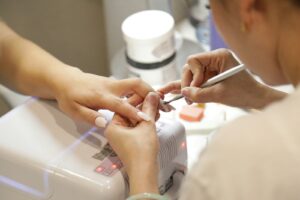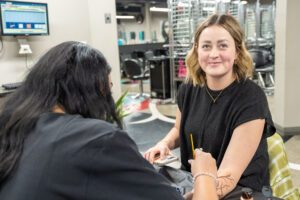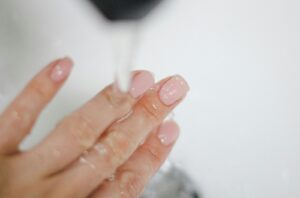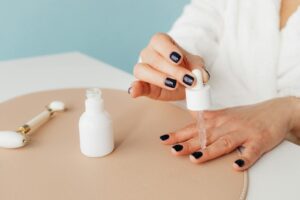Safely Remove Acrylics Without Damaging Your Natural Nail
Acrylic nails have become a staple in beauty and fashion, offering an easy way to achieve long, durable, and beautifully manicured nails. However, when it comes time to remove acrylic nails, doing so safely and effectively at home can be a concern for many. At Cameo College, we aim to provide our prospective beauty students with the knowledge and skills necessary to handle such tasks with confidence. Understanding the intricacies of acrylic nail removal not only protects your natural nail but also sets the foundation for those interested in pursuing a career in beauty and nail care.
Understanding Acrylic Nails

Photo by Giorgio Trovato on Unsplash
What Are Acrylic Nails?
Acrylic nails are a popular form of nail enhancement that involves applying a mixture of liquid monomer and powdered polymer over the natural nail or on nail tips. This combination hardens into a strong, protective layer that can be shaped and painted to achieve a desired look. Acrylic nails are known for their durability and versatility, making them a favored choice for those looking to extend the length and modify the appearance of their natural nails. As a beauty school, we emphasize the importance of understanding the chemical and physical properties of acrylics, which is crucial for proper application and removal techniques.
Benefits of Acrylic Nails
The benefits of acrylic nails are numerous, which is why they remain a popular choice among nail enthusiasts. Acrylics offer a long-lasting manicure that can withstand daily wear and tear, providing a robust solution for those with brittle or weak nails. They also allow for creative freedom, as they can be customized with various colors, designs, and adornments. Moreover, acrylics are less likely to chip compared to natural nails, making them an attractive option for those who desire a polished look that lasts. At Cameo College, we teach our students how to maximize these benefits while ensuring the health of the natural nail is maintained.
Risks of Acrylic Nails
Despite their advantages, acrylic nails come with certain risks that must be managed to avoid damaging your natural nail. Over time, the use of acrylics can lead to weakening of the nail bed, especially if removal processes are not conducted carefully. Furthermore, improper application or removal can cause trauma to the cuticle and surrounding skin. It is crucial for aspiring nail techs to learn the safest way to remove acrylics, such as soaking your nails in acetone or using a nail file to gently break down the acrylic, in order to minimize potential damage. Education in these techniques is vital to ensure nail health and safety.
How to Safely Remove Acrylic Nails at Home

Become a Nail Technician
The Safest Way to Remove Acrylics
At Cameo College, we emphasize the importance of safely removing acrylic nails to protect the natural nail and surrounding skin. The safest way to remove acrylics involves using acetone, a powerful solvent that effectively breaks down the acrylic. Here is a step-by-step guide for the removal process:
- Begin by trimming down the acrylic nails to reduce length and make the removal process easier.
- Soak cotton balls in acetone and place them on each nail, securing them with aluminum foil to ensure maximal contact and efficiency.
This process allows the acetone to soften the acrylic, making it easier to gently push off with a cuticle pusher. Patience is key, as rushing can damage your natural nail and cuticle.
Steps to Remove Acrylic Nails Without Damage
To remove acrylic nails without damaging your natural nail, follow these careful steps:
- Start by filing the top layer of the acrylic to break the seal, which facilitates a quicker soaking process.
- Next, soak your nails in acetone or use acetone-soaked cotton balls to soften the acrylic layer slowly.
- Once softened, use a cuticle pusher to gently remove the acrylic without applying excessive force.
- Repeat the soaking and pushing steps if necessary until all the acrylic is removed.
- After the removal, wash your hands thoroughly and apply cuticle oil to nourish the nail bed and keep your nails healthy after the process.
What to Expect After Acrylic Removal
After removing acrylic nails at home, it’s common to notice that your natural nails may appear weakened or slightly damaged. The nail bed may feel sensitive, and the nails can be thinner than usual. It is crucial to nurture your real nails back to health by avoiding new acrylic or gel applications immediately. Instead, focus on hydrating and strengthening your nails with regular applications of cuticle oil and nourishing nail strengtheners. Over time, with proper care and attention, your natural nails will regain their strength and vitality. At Cameo College, we teach our students to prioritize nail health, ensuring they are well-equipped to advise clients on effective aftercare practices.
Alternative Methods for Acrylic Nail Removal

Removing Acrylic Nails Without Acetone
For those who wish to remove acrylic nails without using acetone, alternative methods can be effective and gentle on the natural nail. One option is to use a dental floss or a metal nail file. Begin by trimming the acrylic nails to a manageable length. Then, gently insert the dental floss under the edge of the acrylic and slowly work it back and forth to lift the acrylic nail away from the natural nail. Another method involves soaking your nails in warm water mixed with a few drops of oil, which helps to loosen the adhesive. These techniques require patience and care to avoid damaging your natural nail and the nail bed.
Using Gel for Acrylic Nail Removal
An innovative approach to removing acrylic nails is by utilizing gel products designed for acrylic removal. These gels work by softening the acrylic, making it easier to remove without the need for harsh chemicals. Apply the gel generously over the acrylic, ensuring full coverage, and allow it to sit for the recommended time. This process causes the acrylic to break down, much like soaking in acetone. Once softened, gently use a cuticle pusher to remove the acrylic from your nail. This method can be a safer way to remove acrylic nails at home without causing undue stress to the natural nail or surrounding cuticle.
Tips for Fully Removing Acrylics at Home
Successfully removing acrylic nails at home involves a few key tips to ensure the process is smooth and damage-free. Begin by keeping your nails trimmed and filed to prevent excessive pulling. Always use appropriate tools, such as a cuticle pusher or a wooden stick, to help lift and remove the acrylic safely. Avoid prying or forcing the acrylic off, as this can damage your nail. After removal, nourish your nails by applying cuticle oil and a strengthening treatment to keep your nails healthy. Regular maintenance and hydration will help your real nails recover and maintain their natural beauty after acrylic removal.
Post-Removal Care for Natural Nails

Photo by Photo By: Kaboompics.com on Pexels
How to Care for Your Natural Nails After Acrylic Removal
Once you have successfully taken off acrylic nails, it’s crucial to focus on restoring the health of your natural nails. Start by gently washing your hands and thoroughly drying them to remove any acetone residue. Applying cuticle oil is a vital step, as it helps in hydrating the nail bed and surrounding skin. Using a rich hand cream will also keep your nails and skin nourished. It’s advisable to avoid getting acrylic nails or gel nails immediately after removal to allow your natural nails to recover. Instead, consider applying a nourishing nail strengthener to help your nails regain their natural strength. Regular maintenance and hydration are key to keeping your nails healthy and strong.
Strengthening Your Nails After Acrylics
Strengthening your nails after removing acrylics is essential to prevent damage and promote growth. Here are some steps you can follow:
- Soak your nails in a mixture of warm water and a few drops of nourishing oil to soften and hydrate them. This can help in minimizing any brittleness or peeling.
- Use a nail file to gently smooth the edges and prevent snagging.
- Incorporate a biotin supplement into your diet to support nail growth from the inside.
- Regularly apply a hardening treatment to reinforce the nail structure.
By taking these steps, you can prevent further damage and ensure your natural nails regain their strength and resilience over time.
Signs of Damage to Look Out For
After acrylic nail removal, it’s important to monitor your natural nails for signs of damage. Look out for any unusual changes such as white spots, ridges, or discoloration, as these could indicate issues with the nail bed or underlying health problems. Weakness or excessive thinning of the nail plate is common after wearing acrylics and can take time to rectify. If you notice any persistent pain or inflammation around the cuticle area, it may be wise to consult a professional nail tech for advice. At Cameo College, we train our students to identify and address such issues, ensuring the health of natural nails is always prioritized.

